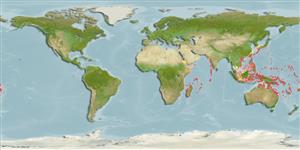Common names from other countries
Classification / Names / Names
Namen | Synonyme | Catalog of Fishes (gen., sp.) | ITIS | CoL | WoRMS
Environment: milieu / climate zone / depth range / distribution range
Ökologie
Riff-verbunden; tiefenbereich 0 - 25 m (Ref. 108901), usually 0 - 10 m (Ref. 108901). Tropical
Indo-West Pacific: East Africa to Papua New Guinea and Australia.
Length at first maturity / Size / Gewicht / Alter
Maturity: Lm ? range ? - ? cm Max length : 48.0 cm TL Männchen/unbestimmt; (Ref. 80470); common length : 35.0 cm TL Männchen/unbestimmt; (Ref. 80470); max. veröff. Gewicht: 2.8 kg (Ref. 122)
Maximum depth from Ref. 92930. Found on inner reef flats, coastal lagoons, seagrass beds, or sandflats at depths of 0 to 30 m (Ref. 92930). Occurs predominantly from 0 to 10 m (Ref. 98471). During specific time of the day, it buries in sand or muddy-sand (Ref. 92930).
Life cycle and mating behavior
Geschlechtsreife | Fortpflanzung | Ablaichen | Eier | Fecundity | Larven
Members of the class Holothuroidea are gonochoric and have only one gonad. Spawning and fertilization are both external and some exhibit brooding. Life cycle: Embryos develop into planktotrophic larvae (auricularia) then into doliolaria (barrel-shaped stage) which later metamorphose into juvenile sea cucumbers.
Massin, C., S. Uthicke, S.W. Purcell, F.W.E. Rowe and Y. Samyn. 2009. (Ref. 80470)
IUCN Rote Liste Status (Ref. 130435)
CITES Status (Ref. 108899)
Not Evaluated
Not Evaluated
Bedrohung für Menschen
Harmless
Nutzung durch Menschen
Fischereien: hoch kommerziell
FAO - Fischereien: landings | FishSource |
Tools
Mehr Information
Alter/Größe
Wachstum
Länge-Gewicht
Länge-Länge
Morphologie
Larven
Dichte
Internet Quellen
Estimates based on models
Preferred temperature
(Ref.
115969): 24.7 - 29.3, mean 28.2 (based on 1951 cells).
